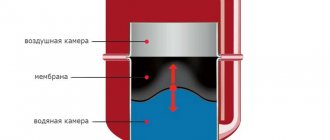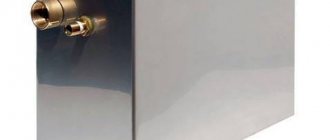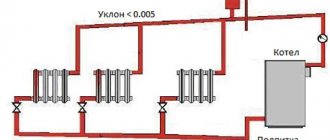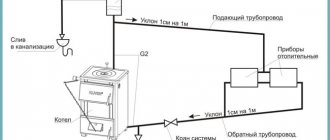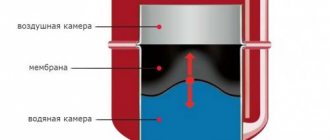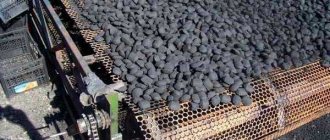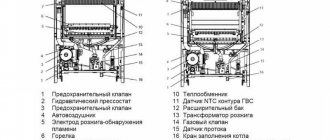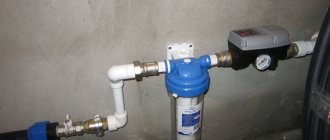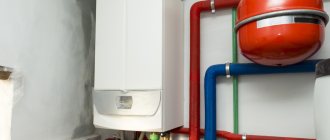Types of heating systems
There are two types of heating systems - closed and open. In a closed system, the coolant circulates in a closed circle (see figure below). When open, it enters the heating system, gives off heat and leaves it.
Central heating in multi-storey buildings is an example of an open type system. Hot water enters the building, which passes through the radiators and gives off its heat. After this, it returns to the boiler room, thermal station, etc.
Closed-type heating works according to the following scheme:
- A heat source (boiler, heat pump, solar collector, etc.) heats the coolant;
- The coolant enters the heating system;
- Passing through heating devices (warm floors, radiators, fan coils), the coolant gives off heat and is cooled;
- After passing through the heating system, the coolant returns to the heat source.
There are also systems with natural and forced circulation. In the first case, the coolant moves through the pipes due to natural convection. In the second, it is pumped through the system by a circulation pump.
Closed heating system. The coolant circulates in a closed loop from the boiler to the heating devices.
Device
The tanks are manufactured according to standard drawings and they have standard dimensions. Its shape can be rectangular or cylindrical; the tank is equipped with an inspection hatch on top. The tank body has several pipes designed for:
- connecting the pipe through which the coolant enters the tank;
- water drainage for the heating system (circulation pipe);
- connecting the signal (outlet pipe);
- connections to the overflow pipe.
Construction of an expansion tank for a heating system.
The signal (control pipe) is equipped with a shut-off valve and led to the sink. The presence of water in the tank and in the system will be indicated by the flow of water when the shut-off valve is opened.
The condition must be met that the useful volume of the damper corresponds to the increase in the volume of coolant filling the system when heated to the design temperature.
Why do you need an expansion tank?
In closed heating systems, the volume of the coolant varies depending on its temperature (see table). For example, if water is heated from +40°C to +85 degrees, its volume will increase by 2.5%. This may seem like a small value to you, but it is dangerous for the heating system!
| ºС | Expansion coefficient, % | ºС | Expansion coefficient, % |
| 0 | 0.013 | 65 | 1.98 |
| 10 | 0.027 | 70 | 2.27 |
| 20 | 0.177 | 75 | 2.58 |
| 30 | 0.435 | 80 | 2.9 |
| 40 | 0.782 | 85 | 3.24 |
| 50 | 1.21 | 90 | 3.59 |
| 55 | 1.45 | 95 | 3.96 |
| 60 | 1.71 | 100 | 4.34 |
The fact is that water or coolant is not compressed - it puts pressure on pipes, fittings, and heating devices. Even slight expansion can lead to leaks. To compensate for this, an expansion tank is used.
Water in central heating systems does not differ in quality; it may contain air. Over time, it accumulates in the upper points of radiators, which is why they heat the room worse.
In closed systems, the coolant may react with the heating system material. which causes gas to be released. Over time, some coolant components may also decompose, releasing air or other gases.
If ordinary water circulates through your closed system, it can also cause air locks. It may contain impurities that react with the material of pipes, fittings and heating devices.
The expansion tank serves as a kind of catcher and reservoir for air and gases. Once they get into it, they no longer return to the general system. Installing a tank helps protect against airing of the system and you will not need to bleed air from the heating radiators.
Installation of expansion tank
After making calculations, you can begin installing the heating expansion tank
It is important to choose its location correctly in the overall diagram. This directly depends on the type of system - gravity or forced circulation
Despite the fact that the role of the expansion tank in heating will remain unchanged, incorrect installation can lead to malfunctions.
Open design
Installation diagram of an open expansion tank
Installation of an open expansion tank is carried out at the highest point of the system.
Some experts recommend installing it immediately after the accelerating vertical line. By adding water to the system through the expansion tank, the likelihood of backflow is reduced. Also, in this place in the circuit, the temperature of the coolant is usually the highest and, accordingly, its expansion. You can also connect to the return pipe. But then the operation of the expansion tank in the heating system will be less efficient.
Before installation, we recommend that you familiarize yourself with the general rules and tips:
- Small deviations horizontally and vertically of the structure are allowed. But they should not exceed 2-3°;
- Insulation can be done using basalt wool. She is not afraid of humidity, and most importantly, high temperatures;
- If the pressure inside the heating expansion tank exceeds critically, some of the liquid may fall through the top cover onto the attic floor. It is recommended to provide improved waterproofing of the floor in this area.
A scheduled inspection of the condition of the tank can be done 2 times a month with constant heating operation and always before the first start of the system.
Diaphragm tank
Installation diagram of a membrane expansion tank
Installation of a membrane expansion tank in heating systems is carried out only on the return pipe in front of the circulation pump.
A prerequisite is compliance with the temperature regime in the room. The air heating level should not be less than +5°C. Installation must not be obstructed by foreign objects. The same applies to structural maintenance.
The correct installation of the expansion tank in the heating system is to maintain its level. The structure must stand strictly vertically. Even a slight tilt may cause incorrect operation. For safe servicing, an air valve should be installed on the air chamber to quickly reduce the pressure in it in the event of an emergency.
The fundamental difference between the operation of an expansion tank in a closed-type heating system is the possibility of its quick dismantling. Therefore, it is recommended to install 2 shut-off valves during installation - one on the inlet pipe to the heating system, and the second on the water chamber of the tank. By blocking them, you can quickly dismantle the container to repair it or install a new one.
The video material presents the design features of expansion tanks and their role in the operation of the heating system:
How does an open expansion tank work?
An open expansion tank is simply a container partially filled with coolant. Sometimes there is not even a valve for air to escape, but just a hole.
Open expansion tanks have two big disadvantages. First, they are susceptible to corrosion because they come into contact with open air. Secondly, they can only be installed in systems with natural circulation.
If you have a circulation pump installed that circulates coolant through the system, then it will not go further than the open expansion tank. The coolant will simply fill the tank and overflow.
Functions
The purpose of the damper is to maintain a certain level of hydrostatic pressure and receive some excess amount of water that will appear in the system as a result of the expansion of the coolant when heated. In addition, its presence will make it possible to replenish the loss of water in the event of a slight leak from the system and when the temperature of the coolant decreases. An open expansion tank in the heating system will help remove excess water when the system overflows into the drain.
Also, the expansion tank in the heating system performs another very important function - it collects air released from the water heated in the heat generator.
The entry of air into the system is due to its presence in tap water, and at average room temperature its concentration is about 40 mg/l. Warming the water to 95″ reduces its amount to 3 mg/l. All the air released from the heated water rises through the main riser into the damper, and from it is removed into the atmosphere.
Operating principle of a closed (membrane) expansion tank
The design of a closed expansion tank differs from a closed one in the presence of a membrane. It is impermeable to air and coolant and divides the container into two parts.
The operating principle of a membrane expansion tank is simple. When the coolant heats up, it increases in volume. Under pressure, the membrane rises. This increases the total volume of the heating system and does not put additional pressure on it.
When cooled below a set temperature, the coolant contracts. The membrane lowers and the volume of the heating system decreases. This compensates for the vacuum created by compression of the coolant.
Expansion tank device
In an individual heating system with liquid coolant that is installed and ready for operation, the expansion tank looks approximately as shown in the figure below (Fig. 2).
In some literature, this device is called an “expansomat” - from the English term “expansion” - expansion). The following main types of expansion tanks for heating systems are distinguished:
- Closed tank.
- Open type tank.
Open type expansion tank
In older heating systems, an open type expansion tank was often used. Until now, such devices are installed in systems that do not have circulation pumps that ensure coolant circulation.
Open type expansion tank
However, a tank of such a system has its drawbacks:
- First of all, in such a system it is necessary to constantly monitor the coolant level.
- Water from such a system can evaporate.
- Open type tanks quickly rust when in contact with water.
- The design of a system with an open-type tank involves installing it exclusively at the top point, which is not always possible, and is simply labor-intensive.
Closed expansion tank
In systems in which the coolant circulates through circuits through operating pumps, only closed-type expansion tanks are installed.
tank operation diagram
This is a more complex device, which contains a special membrane located in a hermetically sealed coolant container.
The membranes in such tanks are divided into diaphragm and balloon. In any case, the membrane divides the container into two parts. The first contains inert gas pumped under pressure (to prevent corrosion) or ordinary air, and the second contains excess coolant when the pressure in the heating system increases.
As soon as the temperature of the coolant in such a system increases, the excess part of it rushes into the expansion tank. The membrane changes its configuration (much like a balloon) and the volume of air or gas in another part of the expansion tank decreases. Gases, as is known, are quite easily compressed, but also tend to expand.
closed tank
As the coolant cools, the expanding gases push the membrane and push excess coolant back into the heating system.
Types of closed expansion tanks
With the same basic structure, closed expansion tanks can be divided into several types:
- A tank with a replaceable membrane, also called a flanged tank.
- Tank with non-replaceable membrane.
The cost of tanks of the second type is lower and they are more popular among consumers. However, tanks with replaceable membranes can withstand large pressure drops in the system, which dramatically increases their efficiency. In addition, they are more repairable and the membrane can be replaced if damaged.
The flanged expansion tank can be made in two versions: vertical and horizontal. A distinctive feature of expansion tanks of this type is the absence of contact of the coolant with the surface of the tank. The expanding liquid is inside a kind of cocoon made of a membrane, so there are no reasons for corrosion on the surface of the tank. Such a membrane is quite easy to change: simply unscrew the flange and carry out repair work.
In membrane expansion tanks, the greatest risk of damage to the membrane element occurs at the moment of system startup, when the pressure in it increases abruptly.
When there are large volumes of coolant in the system, the normal pressure level is obtained using a pressure gauge. Such a device is connected to a safety valve, the threshold response value for which in a private home is set to 3-4 bar.
Membrane tank design
The design of a closed expansion tank is very simple. At the top there is a nipple through which air is pumped into the chamber. It is necessary to balance the pressure inside the container.
There is a rubber or polyurethane membrane located right in the middle of the tank. It is sealed and does not allow air or coolant to pass through. The membrane divides the tank into two parts. The lower chamber is designed for coolant, which gets there due to heating and pressure expansion. The upper one is for air under pressure, which prevents the coolant from immediately filling the entire cavity.
The internal structure of the expansion tank is membrane (closed) type.
Expansion tank design
Tanks can be either with the ability to replace the membrane with a new one, or completely non-removable. To secure the tank to the wall, brackets and clamps may be included; to install the tank on the floor, special legs may be included. The tank membrane, in turn, can also be of different designs.
Non-separable models are equipped with a membrane in the form of a diaphragm; less commonly, a membrane in the form of a cylinder is found. It stretches under pressure, so it can be considered an independent water chamber. To replace this type of membrane, a special flange is used.
Expansion tank design
Air pressure in the tank
The water or coolant in the heating system is always under pressure. In private houses it is 1.6-2 atm., in multi-storey houses - many times more. To ensure that the coolant does not lose pressure during normal operation, the upper part of the expansion membrane tank must be filled with air.
The air pressure in the upper chamber should be 0.2 atm. lower than the coolant pressure in the system. A regular bicycle or car pump is suitable for pumping air. The only thing you may need is an adapter.
At the top of the expansion tank there is a nipple with a spool. The operating principle is the same as in car or bicycle wheels. To deflate the air, just press the small tongue inside it.
Some manufacturers fill the tank not with air, but with nitrogen. In fact, this will not change the effectiveness of its work at all. This is an advertising ploy - they are trying to force you to buy more expensive equipment.
Expansion tank functions
What is the purpose of installing an expansion tank? The heating system is filled with a fixed amount of liquid (water or antifreeze), which is prone to thermal expansion. This means that an increase in coolant temperature inevitably leads to an increase in pressure in the system. Since pipes, radiators and other elements of the engineering structure are inelastic, increased pressure will lead to depressurization of the system - a breakthrough will occur at the weakest point.
Water has low compressibility, so a special device is built into the system - a membrane or open tank. Its function is that as pressure increases, air will be compressed. This makes it possible to provide protection against water hammer. The installed expansion tank protects the system from excessive pressure build-up.
Membrane tanks are designed for a closed-type heating system - they are a container with an elastic, waterproof membrane inside, which divides the internal volume into two parts. The membrane is needed to prevent air from coming into contact with the coolant. Otherwise, airing of the network and an increased risk of corrosion of steel elements of the system cannot be avoided.
In an open-type system, the tank communicates with the atmosphere, due to which air is released from the pipes. For this reason, the installation location of an open tank is strictly regulated - it must be located at the highest point of the system.
Calculation of the expansion tank using the formula
If you do not want to go into details, you can install a tank with a capacity of 10% of the total coolant volume. But sometimes it’s better to calculate everything exactly. By equipping a large heating system, you can save a lot.
To calculate the required volume of the expansion tank, you need to know the following:
- Minimum coolant temperature;
- Maximum coolant temperature;
- Heating system volume;
- The percentage of ethylene glycol or propylene glycol in the coolant.
Important!
If you are going to heat a house or cottage where you do not live permanently, be careful when selecting the type of coolant. They have different freezing temperatures and expansion coefficients.
To calculate the volume of the expansion tank you need to use the formula:
V = V1 x ( Q – Q1)
In this formula:
- Q1 – expansion coefficient at minimum temperature (see tables below);
- Q – expansion coefficient at minimum temperature (see tables below);
- V1 – volume of coolant in the heating system in liters;
- V – volume of the expansion tank in liters.
If an expansion tank is already installed in the heat source, then it must be taken into account. To do this, subtract the built-in capacity from the obtained “V” value. The resulting number is the required volume of your expansion tank.
Important!
If you have a forced circulation heating system, the minimum total capacity of the expansion tank is 15 liters.
Thermal expansion coefficient of ethylene glycol solution
| t, °С | 10% | 20% | 30% | 40% | 50% | 60% | 70% | 80% | 90% | 100% |
| 0 | 0.00013 | 0.0032 | 0.0064 | 0.0096 | 0.0128 | 0.016 | 0.0192 | 0.0224 | 0.0256 | 0.0288 |
| 10 | 0.00027 | 0.0034 | 0.0066 | 0.0098 | 0.013 | 0.0162 | 0.0194 | 0.0226 | 0.0258 | 0.029 |
| 20 | 0.00177 | 0.0048 | 0.008 | 0.0112 | 0.0144 | 0.0176 | 0.0208 | 0.024 | 0.0272 | 0.0304 |
| 30 | 0.00435 | 0.0074 | 0.0106 | 0.0138 | 0.017 | 0.0202 | 0.0234 | 0.0266 | 0.0298 | 0.033 |
| 40 | 0.0078 | 0.0109 | 0.0141 | 0.0173 | 0.0205 | 0.0237 | 0.0269 | 0.0301 | 0.0333 | 0.0365 |
| 50 | 0.0121 | 0.0151 | 0.0183 | 0.0215 | 0.0247 | 0.0279 | 0.0311 | 0.0343 | 0.0375 | 0.0407 |
| 60 | 0.0171 | 0.0201 | 0.0232 | 0.0263 | 0.0294 | 0.0325 | 0.0356 | 0.0387 | 0.0418 | 0.0449 |
| 70 | 0.0227 | 0.0258 | 0.0288 | 0.0318 | 0.0348 | 0.0378 | 0.0408 | 0.0438 | 0.0468 | 0.0498 |
| 80 | 0.029 | 0.032 | 0.0349 | 0.0378 | 0.0407 | 0.0436 | 0.0465 | 0.0494 | 0.0533 | 0.0552 |
| 90 | 0.0359 | 0.0389 | 0.0417 | 0.0445 | 0.0473 | 0.0501 | 0.053 | 0.0557 | 0.0584 | 0.0613 |
| 100 | 0.0434 | 0.0465 | 0.0491 | 0.0517 | 0.0543 | 0.0569 | 0.0595 | 0.0621 | 0.0647 | 0.0673 |
Volume expansion coefficient of propylene glycol
| t, °С | 0% | 10% | 20% | 30% | 40% | 50% | 60% | 70% | 80% | 90% | 100% |
| 0 | 0.00013 | 0.00014 | 0.00015 | 0.00015 | 0.00017 | 0.000175 | 0.000185 | 0.00019 | 0.0002 | 0.00021 | 0.00023 |
| 10 | 0.00027 | 0.00029 | 0.00031 | 0.00032 | 0.00035 | 0.00036 | 0.00038 | 0.0004 | 0.00042 | 0.00044 | 0.00047 |
| 20 | 0.00177 | 0.0019 | 0.00203 | 0.00208 | 0.0023 | 0.00239 | 0.00252 | 0.00262 | 0.00275 | 0.00288 | 0.0031 |
| 30 | 0.00435 | 0.00467 | 0.005 | 0.00511 | 0.00565 | 0.00587 | 0.0062 | 0.00644 | 0.00676 | 0.00707 | 0.00761 |
| 40 | 0.00782 | 0.0084 | 0.00899 | 0.00919 | 0.01017 | 0.01056 | 0.01114 | 0.01157 | 0.01216 | 0.0127 | 0.01368 |
| 50 | 0.0121 | 0.013 | 0.01391 | 0.01421 | 0.01573 | 0.01633 | 0.01724 | 0.0179 | 0.01881 | 0.01966 | 0.02117 |
| 60 | 0.0171 | 0.01838 | 0.01966 | 0.02009 | 0.02223 | 0.02308 | 0.02437 | 0.0253 | 0.02659 | 0.02779 | 0.02992 |
| 70 | 0.0227 | 0.0244 | 0.0261 | 0.02667 | 0.02951 | 0.03064 | 0.03235 | 0.0336 | 0.0353 | 0.03689 | 0.03972 |
| 80 | 0.029 | 0.03117 | 0.03335 | 0.03407 | 0.0377 | 0.03915 | 0.04132 | 0.04292 | 0.04509 | 0.04712 | 0.05075 |
| 90 | 0.0359 | 0.03859 | 0.04128 | 0.04218 | 0.04667 | 0.04846 | 0.05116 | 0.05313 | 0.05582 | 0.05834 | 0.06282 |
| 100 | 0.0434 | 0.04665 | 0.04991 | 0.05099 | 0.05642 | 0.05859 | 0.06184 | 0.06423 | 0.06749 | 0.07052 | 0.07595 |
In order to determine the amount of coolant in the heating system, you need to take into account the volume:
- Connected devices (radiators, underfloor heating, etc.);
- Pipes;
- Collector (comb);
- Heat source (for example, how much coolant is in the boiler or boiler coil).
The volume of pipes can be calculated using the formula:
V = L x 0.0785 x D x D
In this formula:
- L – heating pipe length;
- D – diameter in cm;
- V is the volume of coolant in the pipe in liters.
You can see the volume of coolant in the batteries in the specifications or instructions for them. If there are none, you can find out the amount of coolant in the publication “The volume of water in a heating radiator - aluminum, cast iron, bimetallic.”
Features of choice
It may seem to you that the expansion tank has a simple design and you can choose it only based on volume. But there are a few more points to consider:
- The membrane material must be resistant to reagents and additives used in coolants;
- The inside of the tank must be covered with high-quality paint or other coating.
- The protective coating on the inside of the container should not react with the coolant;
- The membrane must be resistant to high temperatures;
- The maximum permissible pressure in the tank must correspond to the characteristics of your heating system;
- All connections and seams must be resistant to high pressure and water hammer.
When expansion tanks are needed
Expansion tanks for heating should be used in the following cases:
- With a large area of the room , because in this case a heating system is used, which may have a large volume. During operation, such a system is subject to constant load, and in order to reduce the pressure inside the pipes, an expansion tank is used. In such cases, it is highly advisable to use a tank, because it will reduce the pressure , thereby protecting your equipment and premises.
- With a relatively long pipe length, it is also highly advisable to use a tank, again to control pressure.
- It is advisable to install a tank when using a gas boiler, because during operation, gas burns in the boiler all the time, and the water becomes very hot. Subsequently, the internal pressure of the pipes can be quite high.
We can conclude that it is always advisable to use a tank, and in the above cases it is highly desirable.

